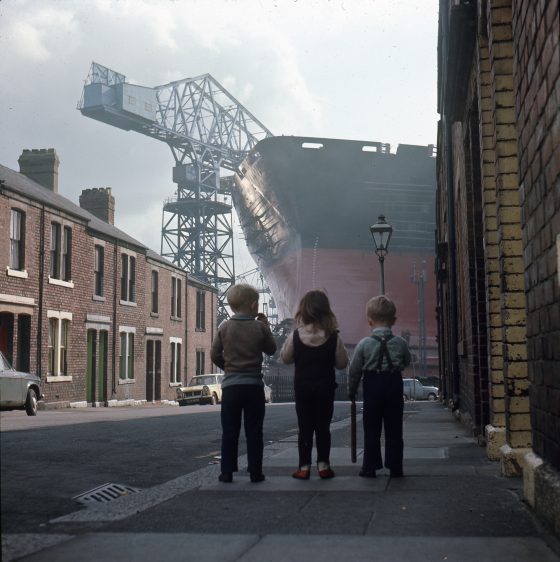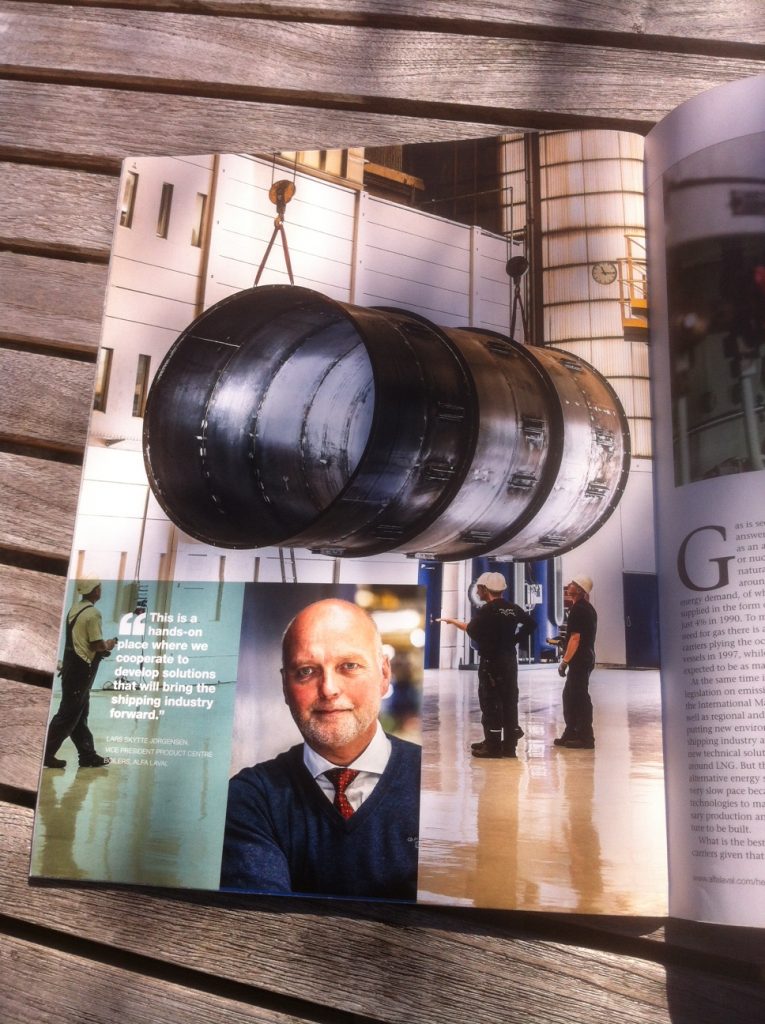
It is said that a picture is worth a thousand words. Even though I am a wordsmith, I have to agree. Photos can really bring a story to life. Let me tell you the story behind this old photo and also behind a recent photo taken for an article I wrote about the marine industry. Both photos illustrate the sheer scale of the construction work in shipping.
Aalborg – where new technology is put to the test
The content agency Spoon in Malmö gave me an assignment to write a long article on the Alfa Laval Test and Training Centre for marine equipment in Aalborg in Denmark. I was grateful to be given the opportunity to write about a thousand words – equivalent to one photo!
The article was for Alfa Laval’s annual corporate magazine here and involved a visit to a construction hall of the former Aalborg shipyard. The quality of the photos for a glossy magazine like here are important. Luckily there was an unusual delivery that happened during my visit. The resulting photo shows dramatically the scale of the new test equipment being installed.
When my interviews and the tour with Alfa Laval’s Lars Skytte Jørgensen and Kenneth Christensen were over by around 2.30 pm, I was scheduled to head for home. As I was about to leave, Kenneth Christensen mentioned that there was a special delivery expected later that afternoon – a 9-metre long steel stack weighing 8 tonnes. It was the outer shell of the gas combustion chamber that I was writing about.
I decided to stay and asked the local freelance photographer Johny Kristensen to wait with me, imagining that there would be a good photo opportunity. The result was some eye-catching photographs as the stack was lifted off the back of a trailer and into the test centre. One of these photos showing the steel tube hoisted into the air above some workers was used in the final article.

The article was a feature on a new combustion unit for use on board liquid natural gas (LNG) carriers. This unit costs millions of Swedish kronor and is a vital piece of safety equipment for burning off excess gas from a cargo of liquid natural gas. A full-scale gas combustion unit was being constructed by Alfa Laval in Aalborg for testing and is now ready.
As part of the article, I also wrote a case story about another part of hall which is designed to operate like a ship, except on dry land. As far as possible, they mimic the operation of a commercial vessel with an engine room and integrated systems complete with auxiliary equipment.
You can download the full article at this link: here-35-aalborg-test-and-training-centre
LNG is thought to be one of the fuels of the future. What I learnt from writing the article is that gas is seen as one of the answers to the world’s fuel needs as an alternative to oil, coal and nuclear power. Today natural gas accounts for around a quarter of global energy demand, of which around 10% is supplied in the form of LNG. To meet the need for gas, there is a growing fleet of LNG carriers plying the oceans. There were 500 such vessels in 2015, but by 2030, there are expected to be as many as 7,000. A new era has begun in shipping. Many of the ocean-going carriers of the future will be loaded with a cryogenic cargo of liquid gas.
Newcastle – memories from the end of an era
I can remember the launches of large oil tankers built along the River Tyne when I was a boy growing up in the North East of England. The old photo shown here was taken by my father around 1975 I believe. He was a keen amateur photographer and liked taking photos of the terraced streets of Byker, Wallsend and Walker near Newcastle upon Tyne. This photo captures the construction of a super-tanker taken from Leslie Street in Wallsend where the Swan Hunter shipyard was located at the bottom of the street with its towering cranes. The very first purpose-built oil tanker, Gluckauf, was actually built in Newcastle upon Tyne in 1886 so Tyneside has a long heritage. In its heyday, Tyneside had a large shipbuilding industry but this photo was taken near the end of an era. The ship shown here, with a deadweight of more than 250,000 tonnes, is one of the last oil tankers built on the Tyne before the shipyards closed.
The last of the huge cranes from Swan Hunter was sold to an Indian shipbuilder called Bharati Shipyard in 2007 bringing to a final close the proud history of shipbuilding on the Tyne.
The photo shows a living street with kids playing and parked cars. My father captured the wonder of the children at the sheer size of the ship at the bottom of their street. The street is no more. These houses were demolished a few years after the photo was taken.
Times change but the grand designs of the shipbuilding industry can still make us feel small.
By Peter Goddard
